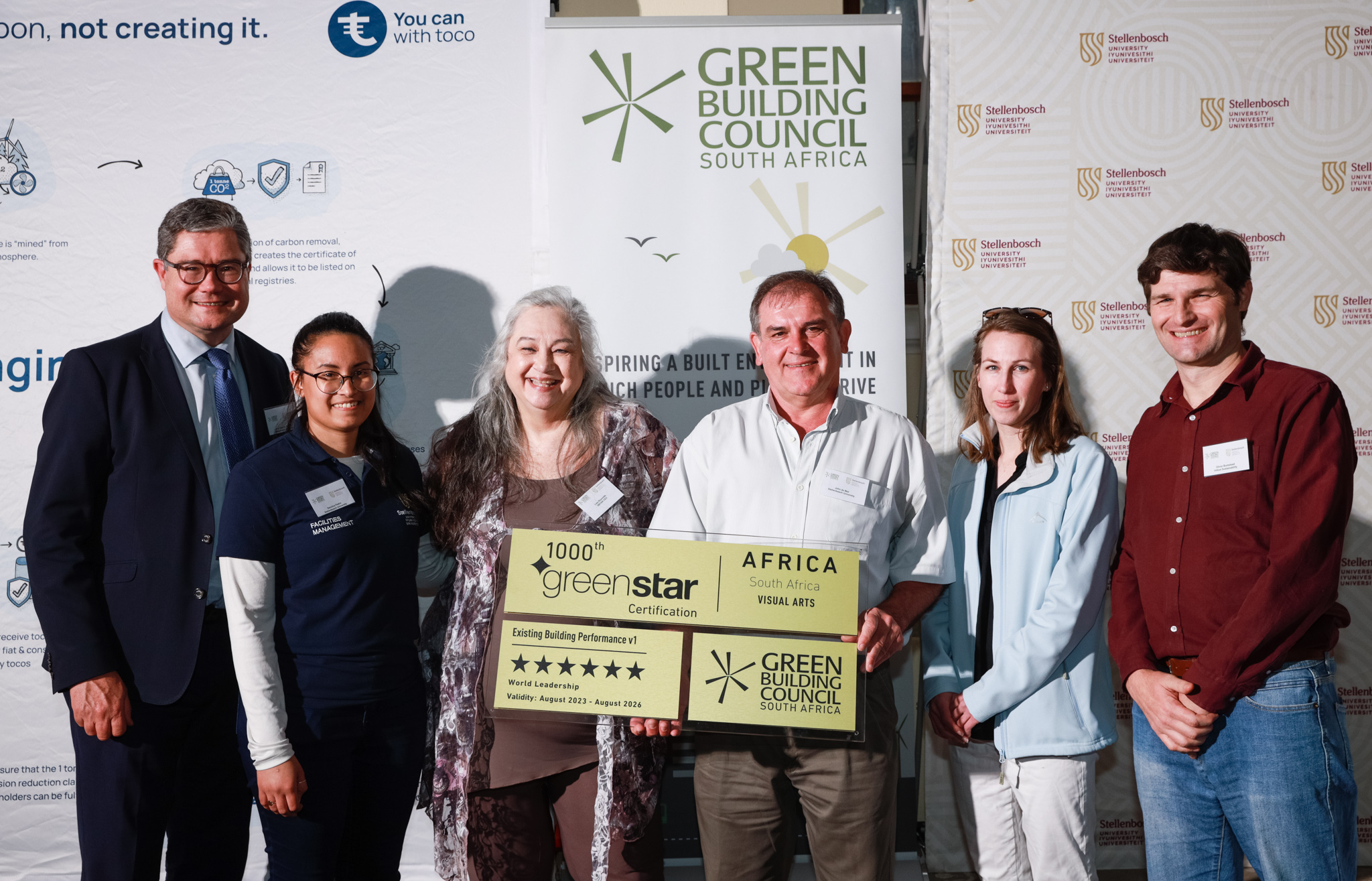
GBCSA’s 1000th Certification Signals Exponential Growth for SA’s Green Buildings Sector
October 04, 2023
Green Building Council South Africa (GBCSA) recently signed-off on its 1000th green building certification since the organisation’s inception in 2007. The 1000th certification, awarded to the Visual Arts Building at Stellenbosch University, is a milestone that’s been 15 years in the making, reflective of a growing appetite for sustainable and resilient green buildings in the South African built environment sector.Notably, the certified structure is a heritage building constructed in 1905, epitomising the transformational capacity of the green buildings’ movement.
One Thousand Steps Forward
As the saying goes, a journey of 1000 miles begins with the first step. The first step to 1000 certifications started in 2009, explains GBCSA CEO, Lisa Reynolds. At the time, no one knew how long it would take to get to 1000 certifications, but the growth has been steady, and then exponential. “It is an amazing place to be in, to pause and reflect on how far we have come, and to look to the future to see that there is still much to be done,” says Reynolds, emphasising that there is still more work needed to mitigate the effects of climate change.
“When GBCSA started, it was primarily focused on the office environment, and we were doing 20 to 30 certifications per year,” says Georgina Smit, GBCSA Head of Technical. “We have evolved to processing approximately 100 certifications per year, and engaging with industry leaders who want to demonstrate their green commitment in the residential, industrial, and tertiary spaces.” In 2022 alone, the organisation certified 165 buildings.
Reynolds adds: “GBCSA’s vision is to be a vital part of the transformation of the built environment to a place where people and planet thrive. The global goal is to halve carbon emissions by 2050. Achieving both goals requires ramping up our efforts. Certifications serve as both a means and a measure to assist in achieving a greener and more resource-efficient future. The 1000th certification is the perfect place to promote a paradigm shift in the built environment.”
It’s also worth noting that GBCSA’s first certification was done prior to the intense electricity and water crises that we have been experiencing. “The energy and water savings within the 1000 certifications have helped avert an even bigger crisis,” says Reynolds.
The annual savings resulting from the 1000 GBCSA certifications, when compared to ‘business as usual’ buildings, equates to 1 320 thousand MWh of energy, 1 590 million kg of CO2 emissions, and 1 220 million litres of water. With savings like these, the benefits of green building become substantial. They also contribute to financial sustainability.
The Benefits of Green
The 6731m² newly certified building houses Stellenbosch University’s Department of Visual Arts. The heritage structure has attained a 6-Star Green Star rating under the Existing Building Performance (EBP) version 1 tool. It’s part of a bulk certification of 18 buildings which indicates the University’s commitment to playing their part.
“Environmental sustainability is a core principle that permeates all aspects of campus life and is deeply integrated into the operations and core business of the institution,” says Environmental Sustainability Manager at Stellenbosch University, John De Wet. The multiple building certifications form part of the university’s Environmental Sustainability Plan to ensure they achieve carbon neutrality by 2030 and net zero by 2050. De Wet emphasises that the process of certifying their buildings will ensure “a more environmentally sustainable institution which will be more resilient, reduce operational costs, reduce greenhouse gas emissions and ultimately the institution’s carbon footprint; healthier, cleaner, and more productive spaces, while improving our biodiversity”.
Certifying a green building offers more than just a handshake for doing a good job and a pretty certificate to put up on the wall. The benefits are tangible. De Wet explains that the certification is helping the university to benchmark their portfolio of buildings against each other, and against best practices. Doing so allows them to identify the gaps in their processes and procedures. In essence, it helps them optimise their portfolio and manage their buildings more efficiently and cost-effectively. An added benefit is how the behaviour change of the building’s users leads to a more sustainable way of doing campus life.
Simon Penso, Green Star accredited professional and founder of Imbue Sustainability, explains that Stellenbosch is the first university in South Africa to achieve EBP certifications, which is an achievement not to be taken lightly. This in itself has some knock-on effects.
Penso adds: “Stellenbosch University has approximately 400 buildings within their organisation, and they are just one of many academic institutions in South Africa, therefore the positive impact that this sector can have with regards to sustainability is hugely significant.
“A large percentage of the building occupants are students which is a fantastic aspect for a few reasons. Firstly, this is often their first exposure to the green building sector and therefore starts raising awareness to a critical demographic. Secondly, those already aware of the importance of sustainability in the built environment are starting to demand change and progress towards a sustainable future. This commitment by the university drives the sustainability agenda forward beyond the bounds of the building itself.”
Beyond One Thousand Certifications
It’s all systems go at the GBCSA to increase capacity to certify a higher number of green buildings per year. This includes identifying ways to streamline the certification process, without compromising standards and robustness. An exciting next step for the sector will be the launch of the pilot phase of GBCSA’s New Build Version 2 Green Star rating tool in 2024.
Ultimately green buildings are here to stay. While there is still much work to be done, it’s encouraging to reflect on past achievements, remembering that each small step contributes to a larger journey to a future where people and planet can thrive.
“As we celebrate this significant milestone of 1,000 certifications, we’re not just planting a stake in the ground, we’re laying the foundation for exponential green thinking,” says Reynolds. “We’ve made good progress, but there’s also a call to action. The next thousand certifications await, and with them, a more sustainable future for South Africa’s built environment sector.”






